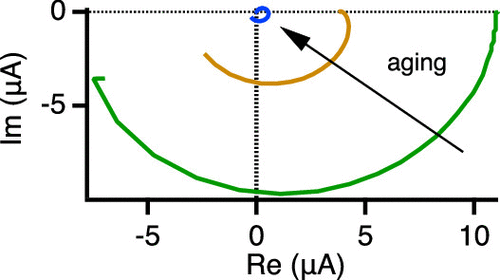当前位置:
X-MOL 学术
›
ACS Appl. Mater. Interfaces
›
论文详情
Our official English website, www.x-mol.net, welcomes your
feedback! (Note: you will need to create a separate account there.)
Unique Degradation Signatures of Organic Solar Cells with Nonfullerene Electron Acceptors
ACS Applied Materials & Interfaces ( IF 8.3 ) Pub Date : 2021-01-22 , DOI: 10.1021/acsami.0c21367 Pranab Deb 1 , Ryan T. Grimm 1 , John K. Grey 1
ACS Applied Materials & Interfaces ( IF 8.3 ) Pub Date : 2021-01-22 , DOI: 10.1021/acsami.0c21367 Pranab Deb 1 , Ryan T. Grimm 1 , John K. Grey 1
Affiliation

|
We investigate the degradation phenomena of organic solar cells based on nonfullerene electron acceptors (NFA) using intensity-modulated photocurrent spectroscopy (IMPS). Devices composed of NIR absorbing blends of a polymer (PTB7) and NFA molecules (COi8DFIC) were operated in air for varying periods of time that display unusual degradation trends. Light aging (e.g., ∼3 days) results in a characteristic first quadrant (positive phase shifts) degradation feature in IMPS Nyquist (Bode) plots that grow in amplitude and frequency with increasing excitation intensity and then subsequently turns over and vanishes. By contrast, devices aged and operated in air for longer times (>5 days) display poor photovoltaic performance and have a dominant first quadrant IMPS component that grows nonlinearly with excitation intensity. We analyze these degradation trends using a simple model with descriptors underlying the first quadrant feature (i.e., trap lifetime and occupancy). The results indicate that the quasi first-order recombination rate constant, krec, is significantly slower in addition to lower trap densities in devices exhibiting light aging effects that are overcome by increasing carrier densities (viz. excitation intensity). By contrast, larger trap densities and distributions coupled with larger krec values are found to be responsible for the continuous growth of the first quadrant with light intensity. We believe that defect formation and charge recombination at device contact interfaces is chiefly responsible for performance degradation, which offers several directions for materials and device optimization strategies to minimize long-term detrimental factors.
中文翻译:

具有富勒烯电子受体的有机太阳能电池的独特降解特征
我们使用强度调制光电流光谱法(IMPS)研究了基于非富勒烯电子受体(NFA)的有机太阳能电池的降解现象。由聚合物(PTB7)和NFA分子的NIR吸收共混物组成的设备在空气中运行不同的时间段,显示出异常的降解趋势。光老化(例如,约3天)会在IMPS奈奎斯特(Bode)图中产生特征性的第一象限(正相移)退化特征,其振幅和频率随激发强度的增加而增加,然后翻转并消失。相比之下,在空气中老化并运行较长时间(> 5天)的设备显示出较差的光伏性能,并且具有占主导地位的第一象限IMPS分量,该分量随激发强度非线性增长。我们使用一个简单的模型来分析这些退化趋势,该模型的描述符位于第一象限特征(即陷阱寿命和占用率)的基础上。结果表明,准一阶复合速率常数为k rec,除了显示出光老化效应的器件中较低的陷阱密度外,还很慢,这可以通过增加载流子密度(即激发强度)来克服。相比之下,发现较大的陷阱密度和分布以及较大的k rec值是导致第一象限随光强度连续增长的原因。我们认为,器件接触界面处的缺陷形成和电荷重组是造成性能下降的主要原因,这为材料和器件优化策略提供了一些指导,以最大程度地减少长期有害因素。
更新日期:2021-02-03
中文翻译:

具有富勒烯电子受体的有机太阳能电池的独特降解特征
我们使用强度调制光电流光谱法(IMPS)研究了基于非富勒烯电子受体(NFA)的有机太阳能电池的降解现象。由聚合物(PTB7)和NFA分子的NIR吸收共混物组成的设备在空气中运行不同的时间段,显示出异常的降解趋势。光老化(例如,约3天)会在IMPS奈奎斯特(Bode)图中产生特征性的第一象限(正相移)退化特征,其振幅和频率随激发强度的增加而增加,然后翻转并消失。相比之下,在空气中老化并运行较长时间(> 5天)的设备显示出较差的光伏性能,并且具有占主导地位的第一象限IMPS分量,该分量随激发强度非线性增长。我们使用一个简单的模型来分析这些退化趋势,该模型的描述符位于第一象限特征(即陷阱寿命和占用率)的基础上。结果表明,准一阶复合速率常数为k rec,除了显示出光老化效应的器件中较低的陷阱密度外,还很慢,这可以通过增加载流子密度(即激发强度)来克服。相比之下,发现较大的陷阱密度和分布以及较大的k rec值是导致第一象限随光强度连续增长的原因。我们认为,器件接触界面处的缺陷形成和电荷重组是造成性能下降的主要原因,这为材料和器件优化策略提供了一些指导,以最大程度地减少长期有害因素。











































 京公网安备 11010802027423号
京公网安备 11010802027423号